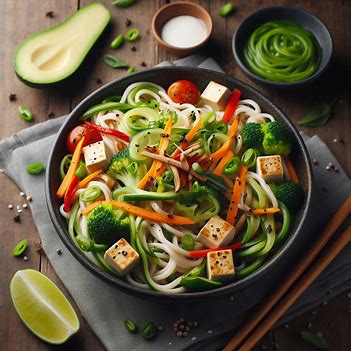
Shirataki noodles with tofu and veggies is a delicious and highly nutritious meal, especially great for those looking for a low-calorie, high-fiber option that’s also packed with plant-based protein. Here’s a breakdown of the key components and how they come together in this dish:
Ingredients:
- Shirataki Noodles: These are traditional Japanese noodles made from the konjac plant, which is incredibly low in calories and high in glucomannan, a type of soluble fiber. Shirataki noodles have a chewy texture and are often used as a low-carb substitute for traditional pasta.
- Tofu: A great source of plant-based protein, tofu is versatile and absorbs the flavors of the sauce and seasonings you use. It’s also rich in calcium and iron.
- Vegetables: You can use a variety of veggies, such as bell peppers, broccoli, carrots, zucchini, or spinach. These add a nutrient boost, flavor, texture, and color to the dish.
- Garlic and Ginger: Often used to flavor stir-fries, garlic and ginger are both anti-inflammatory and antioxidant-rich, boosting the health value of the dish.
- Soy Sauce or Tamari: These provide the savory, umami flavor typical of many Asian-inspired dishes. You can use low-sodium versions if you’re managing blood pressure or looking to reduce your sodium intake.
- Sesame Oil: Adds a nutty, rich flavor to the dish. Sesame oil is commonly used in Asian cooking and is also a source of healthy fats.
- Optional Add-ons: You can sprinkle the dish with sesame seeds, green onions, or even some chili flakes for added crunch or heat.
Preparation:
- Prepare the Shirataki Noodles: Shirataki noodles often come packed in water, so you need to drain and rinse them well to remove the natural odor. After rinsing, dry them thoroughly and lightly pan-fry them for a few minutes to improve their texture.
- Cook the Tofu: You can either sauté or bake the tofu. Cut the tofu into cubes and press it to remove excess water. Toss it in a little oil and soy sauce, and cook until golden and crispy on the outside.
- Sauté Vegetables: In a pan, sauté your vegetables in a little sesame oil along with garlic and ginger. You can cook the vegetables to your preferred level of tenderness.
- Combine Everything: Add the prepared noodles and tofu to the pan with the vegetables. Toss everything together, adding a splash of soy sauce or tamari to taste.
- Serve and Garnish: Serve hot, and garnish with sesame seeds, green onions, or other toppings as desired.
Health Benefits:
- Low in Calories and Carbs: Shirataki noodles are perfect for people looking to reduce calorie intake or follow a low-carb diet without sacrificing volume or satisfaction.
- High Fiber: The glucomannan in shirataki noodles is a form of soluble fiber that can aid digestion, promote feelings of fullness, and help regulate blood sugar levels.
- Plant-Based Protein: Tofu provides complete protein, making this dish suitable for vegetarians or those looking to reduce meat intake.
- Rich in Vitamins and Minerals: The vegetables in this dish contribute various vitamins, minerals, and antioxidants, making it a nutrient-dense meal.
- Heart-Healthy: The use of sesame oil, tofu, and vegetables provides healthy fats and plant-based nutrients that can support heart health, especially if you opt for low-sodium soy sauce or tamari.
This dish is versatile and can be adapted to different tastes by swapping out vegetables or adding different seasonings. Would you like to explore any specific variations or modifications?